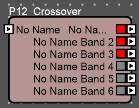

The Audio Architect Crossover is a fully featured loudspeaker management processor consisting of various alignments of crossover filters, gain controls, and mid-band limiters. The limiter is a two-stage protection limiter for protecting against amplifier clipping and loudspeaker damage. The first stage has ballistics suitable for long term protection whilst retaining transparency and minimizing signal level loss. The second stage has much faster ballistics to protect against loudspeaker over-excursion. Limiter ballistics are automatically set by the system to give the optimum performance based on the high-pass frequency of the band. Options include delays, phase filters and limiter metering.
The single channel crossover has
One common audio input and one audio output per band
When the option for Inserts On is selected, there is one input per band.
The stereo crossover has
2 audio inputs and 2 audio outputs per band
When the option for Inserts On is selected, there are 2 inputs per band.
Adjustment of controls has the same effect on both input channels and the corresponding band output channels.
Delays (off/on): A delay-line may be inserted into each band for aligning loudspeaker drivers in time.
Low Frequency Optimization: Defaults to YES. Optimized IIR filter for improved low frequency performance. This is optional to maintain backwards compatibility with existing designs.
Number of Bands (1-6): Select the number of output bands in the crossover.
Stereo: When checked, the Crossover is in Stereo mode.
Inserts (off/on): The input feeds to the crossover filters are normally internally connected together to form a single common input, they may optionally be split into separate inputs so that equalization (for example) can be uniquely applied to individual outputs without disturbing the calibration of the limiter.
Meters (off/on): Metering may be added to monitor the action of the limiters.
Phase Filters (off/on): Phase filters may be included to apply phase shifts between adjacent bands for fine-tuning alignment.
Filters (out/24dB/48dB): For each band the high and low filter roll-off slopes can be set individually.
Signal Names: Custom signal names can be inserted for each output band. Placing the '$' symbol in front of the name will cause that output name to be preceded by the signal name at the input.

The graphical representation of crossover areas indicates what part of the frequency range each band occupies. Each band is represented by a different colour curve. A triangular control handle is provided at each band edge, an upward triangle for the lower band edge and a downward triangle for the upper band edge. These are initially paired with the corresponding control handle of the adjacent band edge at thge same frequency, but can be split to provide a frequency offset between bands. A further set of control handles allow the crossover point of both bands to be adjusted together maintaining any offset.
Filter Type: This combo box selects the type of response for a crossover band edge (the crossover filter 'shape'). Note that the shape can be set differently on each band edge and, even on adjacent band edges, although this latter situation is probably best avoided in audio terms.
The filter types available are:
Butterworth 6, 12, 18, 24 and 48dB/Octave
Bessel 12 and 24dB/Octave
Linkwitz-Riley 12 and 24dB/Octave
Neville Thiele Method 36 and 52dB/Octave
Frequency: Drag nodes horizontally with the mouse to change the crossover frequency. Normally the node at the intersection of two adjacent bands would be moved so that the adjacent bands track together. Some applications require adjacent crossover frequencies to be offset (overlapped for example). This can be done by selecting one band edge so it can be moved independently. Alternatively, the Frequency control below the window may be adjusted.
Gain control: Trims the output level of the band. The gain control is before the limiter, so does not alter the calibration of the limiter threshold.
! This control is capable of raising signal levels beyond the clipping point; so, care should be exercised when using positive gain values.
Delay spin box (for each band): This sets a delay time on the band with default units in milliseconds. Units may be changed in the properties grid to metres, feet or frames.
Polarity button: Reverses the polarity of the band.
Mute button: Silences the band output.
Limiter Threshold control: Adjusts the level threshold above which limiting will take place. If other processing objects are connected between the output of the crossover and the output, the limiter threshold setting may be inaccurate, and the user must compensate for level changes which occur in these objects.
Meter: Displays the input signal level relative to the limiter threshold. A reading of 0dB corresponds to the limit threshold, whereas a reading of +6dB for instance means the signal is exceeding the threshold by 6dB, and is being compressed by 6dB.
Phase spin box (on control panel): Adjusts the phase shift applied between a pair of bands. As there is some interaction between the phase controls, it is recommended that the highest frequency band phase be adjusted first, and then successively lower ones.